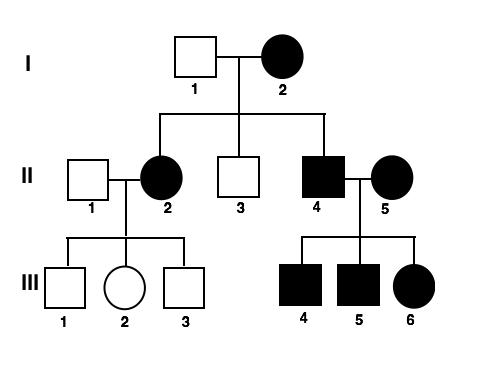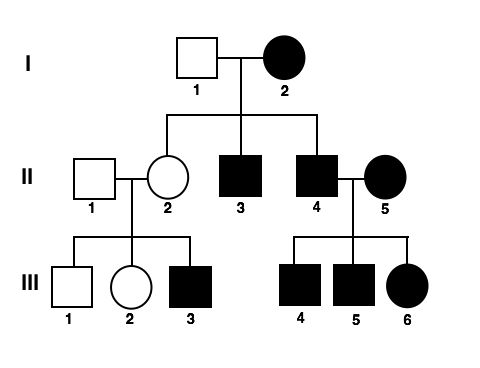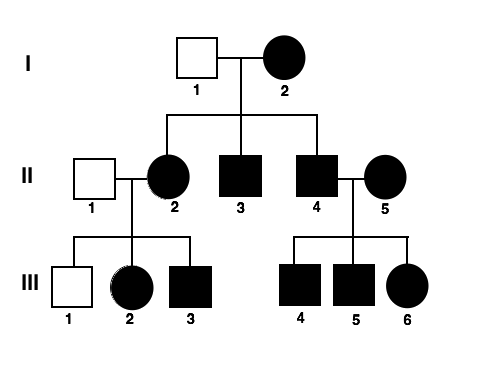7.4 Application: Practicing Inheritance Probabilities
Practicing Inheritance Probabilities: Earlobes, Duchenne Muscular Dystrophy, Dimples
Practicing Inheritance Probabilities: Earlobes, Duchenne Muscular Dystrophy, Dimples (text version)

- The pedigree in Fig. 7.5a tracks the presence of attached earlobes through a family’s generations. Having attached earlobes is an autosomal recessive trait. If individual III-6 married a man who was homozygous for unattached earlobes, what is most likely to be true regarding their children? Check your answer in footnote[1]
- The children would all have partially attached earlobes.
- All the female children will have unattached earlobes, and all the male children will have attached earlobes.
- All of their children would have unattached earlobes.
- All of their children would have attached earlobes.
- The pedigree in Fig. 7.5a tracks the presence of attached earlobes through a family’s generations. Having attached earlobes is an autosomal recessive trait. If individuals I-1 and I-2 had a fourth child, what is the chance that the child would have attached earlobes? Check your answer in footnote[2]
- 50%
- 75%
- 0%
- 100%
- The pedigree in Fig. 7.5a above tracks the presence of attached earlobes through a family’s generations. Having attached earlobes is an autosomal recessive trait. What is the genotype of individual I-1? Check your answer in footnote[3]
- ee
- XeY
- EE
- Ee
- The pedigree Fig. 7.5a above tracks the presence of attached earlobes through a family’s generations. Having attached earlobes is an autosomal recessive trait. What is the genotype of individual II-3? Check your answer in footnote[4]
- ee
- XeY
- EE
- Ee
-

Fig. 7.5b Duchenne Muscular Dystrophy The pedigree in Fig. 7.5b tracks Duchenne Muscular Dystrophy (DMD) through several generations. DMD is an X-linked recessive trait.
If individuals I-1 and I-2 had another son, what is the chance that he would have DMD? Check your answer in footnote[5]
- 0%
- 25%
- 50%
- 100%
- The pedigree in Fig. 7.5b tracks Duchenne Muscular Dystrophy (DMD) through several generations. DMD is an X-linked recessive trait.Based on the pedigree, which of the following is true? Check your answer in footnote[6]
- Individual II-3 has a genotype of XDY.
- If individuals II-4 and II-5 have a fourth child, there is a 50% chance that it will not have DMD.
- Individual II-1 is a carrier for DMD.
- If individual III-1 marries an unaffected, non-carrier female, none of their offspring will have DMD.
- The pedigree in Fig. 7.5b tracks Duchenne Muscular Dystrophy (DMD) through several generations. DMD is an X-linked recessive trait. What is the genotype of individual II-2? Check your answer in footnote[7]
- XdY
- XdXd
- XDXd
- XDXD
- The pedigree in Fig. 7.5b tracks Duchenne Muscular Dystrophy (DMD) through several generations. DMD is an X-linked recessive trait.If individual II-3 has a child with a carrier woman, what is the percent chance that the child will be a daughter with DMD? Check your answer in footnote[8]
- 100%
- 50%
- 25%
- 0%
-

Fig. 7.5c Presence of dimples. The pedigree in Fig. 7.5c tracks the presence of dimples through a family’s generation. Having dimples is an autosomal dominant trait.
If individuals II-1 and II-2 have a fourth child, what is the probability that the child will have dimples? Check your answer in footnote[9]
- 25%
- 50%
- 75%
- 100%
- The pedigree in Fig. 7.5c tracks the presence of dimples through a family’s generation. Having dimples is an autosomal dominant trait.What is the phenotype of individual III-4? Check your answer in footnote[10]
- Dimples
- No dimples
- dd
- DD
- The pedigree in Fig. 7.5c tracks the presence of dimples through a family’s generation. Having dimples is an autosomal dominant trait.Which of the following individuals is correctly matched with its genotype? Check your answer in footnote[11]
- I-1 → Dd
- II-3 → dd
- II-2 → DD
- III-2 → Dd
- The pedigree in Fig. 7.5c tracks the presence of dimples through a family’s generation. Having dimples is an autosomal dominant trait.If individual III-3 married a woman who was heterozygous for dimples, what is the percent chance their children will have dimples? Check your answer in footnote[12]
- 0%
- 25%
- 75%
- 100%
Step by step solutions
Click to expand the step by step solutions for the above problems
- If individual III-6 married a man who was homozygous for unattached earlobes, what is most likely to be true regarding their children?
- Because the trait we are tracking (attached earlobes) is autosomal recessive, shaded individuals, like III-6, will have a homozygous recessive genotype (ee).
- If III-6 (ee) were to have a child with a man who was homozygous for unattached earlobes (EE), then all of the children would be heterozygous – getting one E from their father and one e from their mother.
Attached earlobes is a recessive trait and will only occur in ee genotypes. Heterozygotes (Ee) will have unattached earlobes, as that is the dominant condition. - The correct answer is
All of their children would have unattached earlobes.
- If individuals I-1 and I-2 had a fourth child, what is the chance that the child would have attached earlobes?
- Because the trait we are tracking (attached earlobes) is autosomal recessive, shaded individuals, like I-2, will have a homozygous recessive genotype (ee).
I-1 must have a heterozygous genotype because he is able to pass on a recessive allele to some of his offspring (II-2 and II-4). - If I-1 and I-2 had another child, the cross would be:
– E e e Ee ee e Ee ee Only offspring with ee genotypes will have attached earlobes (2/4 boxes).
2÷4=0.5=50%
- The correct answer is 50%
- Because the trait we are tracking (attached earlobes) is autosomal recessive, shaded individuals, like I-2, will have a homozygous recessive genotype (ee).
- What is the genotype of individual I-1?
- Individual I-1 is represented by a non-shaded square, indicating that it is a male with unattached earlobes.
- Because the trait we are tracking, attached earlobes, is autosomal recessive, shaded individuals will have a homozygous recessive genotype (ee).
Individuals that are non-shaded will have at least one E allele. - I-1 has children with attached earlobes (II-2 and II-4 are ee), meaning he must be able to pass on at least e allele. However, he shows the dominant condition, so he must also have one E allele.
Therefore, his genotype is Ee. - The correct answer is Ee
- What is the genotype of individual II-3?
- Individual II-3 is represented by a non-shaded square, indicating that it is a male with unattached earlobes.
- Because the trait we are tracking, attached earlobes, is autosomal recessive, shaded individuals will have a homozygous recessive genotype (ee).
Individuals that are non-shaded will have at least one E allele. - II-3 has a mother with attached earlobes (ee), meaning he must get one e allele from her. However, he shows the dominant condition, so he must also have one E allele.
Therefore, his genotype is Ee. - The correct answer is Ee
- If individuals I-1 and I-2 had another son, what is the chance that he would have DMD?
- Individual I-2 is represented by a shaded circle, indicating that it is an affected female.
Therefore, she must have a homozygous recessive genotype of XdXd - Because males always get their X chromosome from their mother, all of the sons that individual 2 has will receive a recessive Xd allele.
- Males will also receive their Y chromosome from their father, giving any son of individuals I-1 and I-2 a genotype of XdY
- The correct answer is 100%.
- Individual I-2 is represented by a shaded circle, indicating that it is an affected female.
- Based on the pedigree, which of the following is true?
- Unaffected males, such as individual II-1 have a genotype of XDY.
On the other hand, affected males, such as individual II-3, have a genotype of XdY.
Since males only have one X chromosome, they cannot be carriers. - Individuals II-4 and II-5 are both shaded in, indicating that they are affected.
In order to be affected, they must have the recessive genotypes XdY and XdXd. This means that any child they have will have DMD because each parent can only pass on a recessive DMD allele. - Individual III-1 is an unaffected male, meaning that he has a genotype of XDY.
If he mates with an unaffected, non-carrier female (XDXD), there is no chance that the children will inherit the DMD allele. - The correct answer is
If individual III-1 marries an unaffected, non-carrier female, none of their offspring will have DMD.
- Unaffected males, such as individual II-1 have a genotype of XDY.
- What is the genotype of individual II-2?
- Individual II-2 is represented by a non-shaded circle, indicating that it is an unaffected female.
- In order for individual II-2 to have a normal phenotype, but also produce an affected son, she must be a carrier for DMD. This means that she has one of each allele, XDXd.
- The correct answer is XDXd
- If individual II-3 has a child with a carrier woman, what is the percent chance that the child will be a daughter with DMD?
- Individual I-3 is represented by a shaded square, indicating that it is an affected male. Therefore, he must have a genotype of XdY.
If he has a child with a DMD carrier (XDXd), the cross would be:– XD Xd Xd XDXd XdXd Y XDY XdY - In order for a daughter to be affected, her genotype must be XdXd.
Only one box has this genotype, so the chances of having an affected daughter is: ¼ =25% - The correct answer is 25%
- Individual I-3 is represented by a shaded square, indicating that it is an affected male. Therefore, he must have a genotype of XdY.
- If individuals II-1 and II-2 have a fourth child, what is the probability that the child will have dimples?
- Because the trait we are tracking, dimples, is autosomal dominant, any shaded individuals will have at least one dominant allele (D).
Any unshaded individuals will have the recessive genotype (dd). - II-2 has dimples, meaning she must have at least one D allele. In addition, she has a recessive parent, and one of her children has no dimples (dd), so she must also have at least one d allele. This makes her genotype Dd.
Individual II-1 has no dimples, meaning that he must have a homozygous recessive genotype (dd). - Now that we know their genotypes, if we perform a cross between individuals II-1 and II-2 we find:
– D d d Dd dd d Dd dd 2÷4=50%
- The correct answer is 50%.
- Because the trait we are tracking, dimples, is autosomal dominant, any shaded individuals will have at least one dominant allele (D).
- What is the phenotype of individual III-4?
- Phenotype is the physical characteristic that we see (ex: dimples).
A genotype is the allele combination (ex: DD) - Because the trait we are tracking is having dimples, shaded individuals, like III-4, have dimples. Unshaded individuals, like III-1, do not have dimples.
- The correct answer is Dimples
- Phenotype is the physical characteristic that we see (ex: dimples).
- Which of the following individuals is correctly matched with its genotype?
- The trait that we are tracking, dimples, appears to be dominant, as all offspring who have the trait have an affected parent.
Having dimples also does not skip a generation, which suggests that it is likely dominant. - Shaded individuals have dimples, meaning that they must have at least one D allele.
Unshaded individuals, like I-1, do not have dimples, meaning that they must have the homozygous recessive genotype dd. - An individual with dimples can be either DD or Dd.
Individuals like II-2, II-3, and III-2 all have at least one recessive parent. Since the recessive parent can only donate a d, each of them must have a d in their genotype.
Because they all have dimples, we know they must have one D allele as well, giving them all the genotype of Dd. - The correct answer is III-2 → Dd
- The trait that we are tracking, dimples, appears to be dominant, as all offspring who have the trait have an affected parent.
- If individual III-3 married a woman who was heterozygous for dimples, what is the percent chance their children will have dimples?
- Because the trait we are tracking (dimples) is autosomal dominant, any shaded individuals have at least one dominant allele (D).
Any unshaded individuals have the recessive genotype (dd). - Individual III-3 must be heterozygous (Dd) because he has an unshaded father (dd).
If he was to have a child with a woman who was heterozygous for dimples (Dd), then the cross would be:– D d D DD Dd d Dd dd - Dimples is a dominant trait and will occur whenever a dominant allele is present in the genotype.
Homozygous recessive individuals (dd) will have no dimples, as that is the recessive condition.
Looking at the Punnett square, we find that ¾ =75% offspring will have at least one D allele. - The correct answer is 75%
- Because the trait we are tracking (dimples) is autosomal dominant, any shaded individuals have at least one dominant allele (D).
Activity source: Classical Genetics (Khan Academy) By LibreTexts, a derivative of Pedigrees by Khan Academy, CC BY-NC-SA 4.0
Attribution & References
Except where otherwise noted, this content is adapted from the LibreTexts version of Classical Genetics (Khan Academy). / A derivative of Pedigrees by Khan Academy, CC BY-NC-SA 4.0
All Khan Academy content is available for free at www.khanacademy.org
- c. All of their children would have unattached earlobes. ↵
- a. A cross between I-1 and I-2 would produce two offspring with unattached earlobes (Ee) and two offspring boxes with attached earlobes (ee). ↵
- d. I-1 must have a heterozygous genotype because he is able to pass on a recessive allele to some of his offspring (II-2 and II-4). ↵
- d. II-3 must have a heterozygous genotype because he has a mother with attached earlobes, but shows the dominant condition. ↵
- d. Because individual I-2 is affected, she can only pass on a recessive DMD allele to her sons. This means that all of her sons will have DMD. ↵
- d. Individual III-1 is an unaffected male. If he mates with an unaffected, non-carrier female, there is no chance that the children will inherit the DMD allele. ↵
- c. Since DMD is X-linked, individual II-2 needs to be able to pass on a DMD allele to her son. A homozygous dominant genotype would not allow for that. ↵
- c. In order for a daughter to be affected, she must have a genotype XdXd. There is a 1 in 4 chance that they will produce a child with this genotype. ↵
- b. A cross between II-1 and II-2 would produce two boxes with dimpled offspring (Dd) and two boxes with non-dimpled offspring (dd). ↵
- a. Because we are tracking dimples, shaded individuals represent those who have dimples. ↵
- d. Individual III-2 has dimples, meaning she must have 1 D allele. Her father does not have dimples, so he donates a d allele, giving her a genotype of Dd. ↵
- c. This cross has a 3/4 chance of producing individuals that have at least one D allele. Because dimples D is dominant, these individuals will have dimples. ↵

